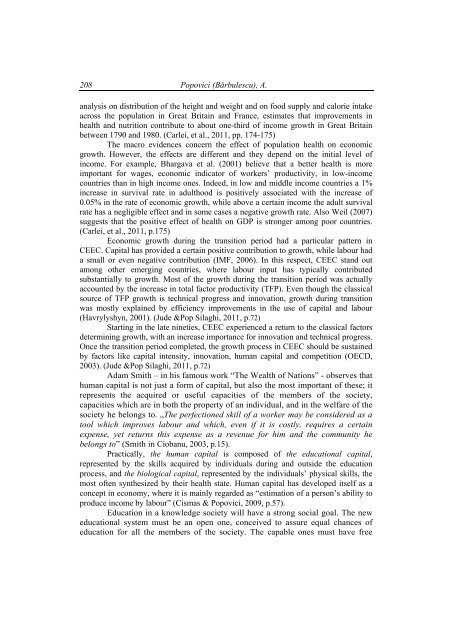annals of the university of petroÅani â¼ economics â¼ vol. xi - part i ...
annals of the university of petroÅani â¼ economics â¼ vol. xi - part i ...
annals of the university of petroÅani â¼ economics â¼ vol. xi - part i ...
You also want an ePaper? Increase the reach of your titles
YUMPU automatically turns print PDFs into web optimized ePapers that Google loves.
208 Popovici (Bărbulescu), A.<br />
analysis on distribution <strong>of</strong> <strong>the</strong> height and weight and on food supply and calorie intake<br />
across <strong>the</strong> population in Great Britain and France, estimates that improvements in<br />
health and nutrition contribute to about one-third <strong>of</strong> income growth in Great Britain<br />
between 1790 and 1980. (Carlei, et al., 2011, pp. 174-175)<br />
The macro evidences concern <strong>the</strong> effect <strong>of</strong> population health on economic<br />
growth. However, <strong>the</strong> effects are different and <strong>the</strong>y depend on <strong>the</strong> initial level <strong>of</strong><br />
income. For example, Bhargava et al. (2001) believe that a better health is more<br />
important for wages, economic indicator <strong>of</strong> workers’ productivity, in low-income<br />
countries than in high income ones. Indeed, in low and middle income countries a 1%<br />
increase in survival rate in adulthood is positively associated with <strong>the</strong> increase <strong>of</strong><br />
0.05% in <strong>the</strong> rate <strong>of</strong> economic growth, while above a certain income <strong>the</strong> adult survival<br />
rate has a negligible effect and in some cases a negative growth rate. Also Weil (2007)<br />
suggests that <strong>the</strong> positive effect <strong>of</strong> health on GDP is stronger among poor countries.<br />
(Carlei, et al., 2011, p.175)<br />
Economic growth during <strong>the</strong> transition period had a <strong>part</strong>icular pattern in<br />
CEEC. Capital has provided a certain positive contribution to growth, while labour had<br />
a small or even negative contribution (IMF, 2006). In this respect, CEEC stand out<br />
among o<strong>the</strong>r emerging countries, where labour input has typically contributed<br />
substantially to growth. Most <strong>of</strong> <strong>the</strong> growth during <strong>the</strong> transition period was actually<br />
accounted by <strong>the</strong> increase in total factor productivity (TFP). Even though <strong>the</strong> classical<br />
source <strong>of</strong> TFP growth is technical progress and innovation, growth during transition<br />
was mostly explained by efficiency improvements in <strong>the</strong> use <strong>of</strong> capital and labour<br />
(Havrylyshyn, 2001). (Jude &Pop Silaghi, 2011, p.72)<br />
Starting in <strong>the</strong> late nineties, CEEC experienced a return to <strong>the</strong> classical factors<br />
determining growth, with an increase importance for innovation and technical progress.<br />
Once <strong>the</strong> transition period completed, <strong>the</strong> growth process in CEEC should be sustained<br />
by factors like capital intensity, innovation, human capital and competition (OECD,<br />
2003). (Jude &Pop Silaghi, 2011, p.72)<br />
Adam Smith – in his famous work “The Wealth <strong>of</strong> Nations” - observes that<br />
human capital is not just a form <strong>of</strong> capital, but also <strong>the</strong> most important <strong>of</strong> <strong>the</strong>se; it<br />
represents <strong>the</strong> acquired or useful capacities <strong>of</strong> <strong>the</strong> members <strong>of</strong> <strong>the</strong> society,<br />
capacities which are in both <strong>the</strong> property <strong>of</strong> an individual, and in <strong>the</strong> welfare <strong>of</strong> <strong>the</strong><br />
society he belongs to. „The perfectioned skill <strong>of</strong> a worker may be considered as a<br />
tool which improves labour and which, even if it is costly, requires a certain<br />
expense, yet returns this expense as a revenue for him and <strong>the</strong> community he<br />
belongs to” (Smith in Ciobanu, 2003, p.15).<br />
Practically, <strong>the</strong> human capital is composed <strong>of</strong> <strong>the</strong> educational capital,<br />
represented by <strong>the</strong> skills acquired by individuals during and outside <strong>the</strong> education<br />
process, and <strong>the</strong> biological capital, represented by <strong>the</strong> individuals’ physical skills, <strong>the</strong><br />
most <strong>of</strong>ten syn<strong>the</strong>sized by <strong>the</strong>ir health state. Human capital has developed itself as a<br />
concept in economy, where it is mainly regarded as “estimation <strong>of</strong> a person’s ability to<br />
produce income by labour” (Cismas & Popovici, 2009, p.57).<br />
Education in a knowledge society will have a strong social goal. The new<br />
educational system must be an open one, conceived to assure equal chances <strong>of</strong><br />
education for all <strong>the</strong> members <strong>of</strong> <strong>the</strong> society. The capable ones must have free

















